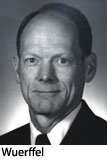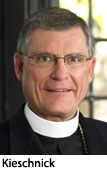Military chaplaincies received attention from leaders of The Lutheran Church–Missouri Synod and the Evangelical Lutheran Church in America (ELCA), meeting as the Committee on Lutheran Cooperation (CLC) on April 6 at the ELCA offices in Chicago.
Reporting on behalf of both the LCMS and ELCA, Rev. Ted Wuerffel, t he Synod’s associate director of Ministry to the Armed Forces, said recruiting chaplains for the armed forces is increasingly difficult. He noted that the larger number of “second-career” seminarians has shrunk the recruiting pool.
he Synod’s associate director of Ministry to the Armed Forces, said recruiting chaplains for the armed forces is increasingly difficult. He noted that the larger number of “second-career” seminarians has shrunk the recruiting pool.
The ELCA has 100 active-duty military chaplains and 175 in the military reserves or National Guard. The LCMS has 89 chaplains on active duty and 115 in the National Guard or reserves. Because of the Iraq war, Wuerffel said, the U.S. Army is more likely to call up National Guard or reserve chaplains — many of them pastors of congregations.
When a mobilized National Guard or reserve chaplain completes a tour of duty, re-entry into a role as congregational pastor can be difficult, said Rev. C. William Hoesman, chairman of the LCMS Council of Presidents and president of the Michigan District. “We do not do well with that,” Hoesman said. “We find that congregations and pastors have issues to deal with sometimes. This has not always been a smooth thing,” he said.
Wuerffel addressed recent concerns about prayer and religious practices in the military, particularly at the U.S. Air Force Academy. In the wake of concerns about the influence of evangelical Christians at the academy, the Air Force issued interim guidelines saying the academy must accommodate the religious beliefs of all cadets and cannot promote a specific faith through its religious practices.
Responding to the interim guidelines, LCMS President Gerald B. Kieschnick shared copies  of a March 14 memo he wrote to the Air Force chief of staff and the secretary of the Air Force. Saying the Synod believes the interim Air Force policy runs counter to the right of every chaplain to pray using Jesus’ name. “…We would like the firm assurance from your office that should any of our chaplains choose for conscience reasons not to pray publicly that they will not receive negative consequences upon their military careers,” he wrote.
of a March 14 memo he wrote to the Air Force chief of staff and the secretary of the Air Force. Saying the Synod believes the interim Air Force policy runs counter to the right of every chaplain to pray using Jesus’ name. “…We would like the firm assurance from your office that should any of our chaplains choose for conscience reasons not to pray publicly that they will not receive negative consequences upon their military careers,” he wrote.
Wuerffel gave an official statement on prayer in the U.S. Navy. It emphasized “mutual respect, cooperation and inclusiveness in delivering prayers at command functions.” It also said that if a chaplain chooses not to pray at an official military function “he or she may do so without adverse consequences.”
Among the other topics, Kieschnick reported that the LCMS has two “blue ribbon” task forces. One is examining how the church will fund its mission and the other is studying church structure and governance.
The ELCA had “a good year” since its 2005 Churchwide Assembly in Orlando, reported Presiding Bishop Mark S. Hanson. He acknowledged that some people were disappointed with the defeat of a proposal that would have made it possible for people who are gay or lesbian and in a committed relationship to serve as ELCA clergy. “As a church body we have a sense that we matured through that experience,” he said.
An “ominous sign” is a statistic suggesting that less than 30 percent of ELCA members are in worship each week, Hanson said. In addition, 54 percent of ELCA congregations have fewer than 100 people in worship.
Discussing finances, Ronald Schultz, administrative officer of the board of directors, said the LCMS expects to finish the fiscal year on June 30 about $2 million behind budget. He said much of that is due to the start-up costs for Fan into Flame, a companion effort of the Ablaze! movement. This year, about $13.3 million was raised for international and domestic disasters, he said.
Rev. Charles S. Miller, ELCA executive for administration and executive assistant to the presiding bishop, said the ELCA’s fiscal year, ending Jan. 31, 2006, was “an outstanding year for us financially.” Income was up, particularly for the World Hunger Appeal, which received $17.7 million in gifts. Gifts for disaster relief, especially tsunami and hurricane relief, were $36.8 million.
The CLC will meet Oct. 3 in St. Louis.
Other LCMS representatives on the CLC were Rev. William R. Diekelman, first vice president; Rev. Raymond L. Hartwig, LCMS secretary and Dr. Samuel H. Nafzger, executive director of the Commission on Theology and Church Relations.
Posted April 27, 2006




